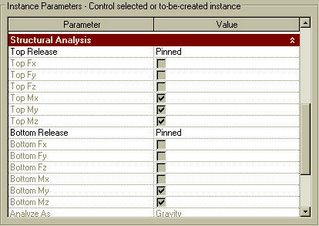
A place for Building Designers and Engineers to keep up with my continuous knowledge growth as an Application Engineer for Autodesk products.
Search This Blog
Monday, January 29, 2007
CAD Shack
Todd Shackelford recently acknowledged my blog and I wanted to return the favor. Todd has an excellent blog site where he focuses on the MEP side by using Autodesk Building Systems and Revit Systems. Check out his blog at CAD Shack. Thanks Todd, and keep up the good work!


Wednesday, January 10, 2007
Not Worrying About What You Don't Know
Well, my absence from blogging is over. I had a very nice Christmas season, and I am looking forward to a new year of blogging.
With a post title like this, I could go several directions. I could use this title to discuss the fear people have about switching over to the Revit Platform. After all, change can be a very big issue for some people. But this is not the direction I am heading. I could use this title to discuss how easy it is to gain a basic understanding of the Revit tools. How the tools work the way they ought to work, even if you don't know how to use them. But this is not the direction I am headed either. Okay, as we tell my father-in-law when he is telling us a story and he gets off subject... enough fluff!
I want to use this post to discuss the most common mistake people make when working on a Revit project. That is worrying about the details before it is time to worry about the details. Revit is a modeling program. Most people tend to want to be as accurate as possible, and show as much detail as they can to "wow" their customers with 3D perspectives. I am here to tell you, that if you spend too much time worrying about specific details in the design phase, then you are missing the point.
You should use Revit as a design tool. When I am in a design stage of a project, I don't care what size the column needs to be or what the exact make-up of the exterior walls are. I just want to focus on the design intent and make sure that the spaces work. As CAD drafters, we sometimes get too caught up in the details too early in the game.
Let me introduce a new Revit term to you. It's called Space Holders. You can use space holders to quickly block out something in your model that you will eventually go back and revise to the correct component. This will allow you to keep focused on the design, not the details. For example, when laying out a building, I know that I will have to have columns in my building, but I may not know where, what type, or the exact size of the column until later in the game. Typically, we give our structural engineers a base plan and they provide us with the column spacing and sizes. So in the early stages, I may just want to use a standard box column in my plans as a preliminary column spacing plan. After my engineer designs the structural model, I can simply exchange my place holder columns with the correctly sized columns by replacing the family. This will save me time and frustration in the design phase.
While I am on the subject of columns, let me take the time to tell you the difference between Architectural columns and Structural columns in Revit. The architectural column is found on the Modeling Design Bar while the structural column is found on the Structural Design Bar. They work and feel basically the same. The only difference between the two is that the structural columns have additional parameters that the engineer can use to extract to his structural design program to size the member. These parameters will be grayed out unless you are running Revit Structural.

If you are working with an engineer that is using Revit, then by all means, use structural columns as opposed to architectural columns. If your engineer is not using Revit, then it really doesn't matter. You can use architectural columns as wrap arounds and structural columns as the actual column. If you are doing this, then when placing the structural columns, you can insert them by selecting your architectural column wrap arounds as the mode of inserting.
 This will save time and insure that your columns and the structural columns are connected. If one moves, the other will move with it. Pretty neat trick to make sure your wrap arounds are in the correct location.
This will save time and insure that your columns and the structural columns are connected. If one moves, the other will move with it. Pretty neat trick to make sure your wrap arounds are in the correct location.
Enough fluff! Back to my original post title. To sum it up, don't get caught up in the details too early in the game. Use place holders when needed, and just make sure that you eventually go back and replace the place holders with the correct components when that knowledge is gained.
With a post title like this, I could go several directions. I could use this title to discuss the fear people have about switching over to the Revit Platform. After all, change can be a very big issue for some people. But this is not the direction I am heading. I could use this title to discuss how easy it is to gain a basic understanding of the Revit tools. How the tools work the way they ought to work, even if you don't know how to use them. But this is not the direction I am headed either. Okay, as we tell my father-in-law when he is telling us a story and he gets off subject... enough fluff!
I want to use this post to discuss the most common mistake people make when working on a Revit project. That is worrying about the details before it is time to worry about the details. Revit is a modeling program. Most people tend to want to be as accurate as possible, and show as much detail as they can to "wow" their customers with 3D perspectives. I am here to tell you, that if you spend too much time worrying about specific details in the design phase, then you are missing the point.
You should use Revit as a design tool. When I am in a design stage of a project, I don't care what size the column needs to be or what the exact make-up of the exterior walls are. I just want to focus on the design intent and make sure that the spaces work. As CAD drafters, we sometimes get too caught up in the details too early in the game.
Let me introduce a new Revit term to you. It's called Space Holders. You can use space holders to quickly block out something in your model that you will eventually go back and revise to the correct component. This will allow you to keep focused on the design, not the details. For example, when laying out a building, I know that I will have to have columns in my building, but I may not know where, what type, or the exact size of the column until later in the game. Typically, we give our structural engineers a base plan and they provide us with the column spacing and sizes. So in the early stages, I may just want to use a standard box column in my plans as a preliminary column spacing plan. After my engineer designs the structural model, I can simply exchange my place holder columns with the correctly sized columns by replacing the family. This will save me time and frustration in the design phase.
While I am on the subject of columns, let me take the time to tell you the difference between Architectural columns and Structural columns in Revit. The architectural column is found on the Modeling Design Bar while the structural column is found on the Structural Design Bar. They work and feel basically the same. The only difference between the two is that the structural columns have additional parameters that the engineer can use to extract to his structural design program to size the member. These parameters will be grayed out unless you are running Revit Structural.

If you are working with an engineer that is using Revit, then by all means, use structural columns as opposed to architectural columns. If your engineer is not using Revit, then it really doesn't matter. You can use architectural columns as wrap arounds and structural columns as the actual column. If you are doing this, then when placing the structural columns, you can insert them by selecting your architectural column wrap arounds as the mode of inserting.
 This will save time and insure that your columns and the structural columns are connected. If one moves, the other will move with it. Pretty neat trick to make sure your wrap arounds are in the correct location.
This will save time and insure that your columns and the structural columns are connected. If one moves, the other will move with it. Pretty neat trick to make sure your wrap arounds are in the correct location.Enough fluff! Back to my original post title. To sum it up, don't get caught up in the details too early in the game. Use place holders when needed, and just make sure that you eventually go back and replace the place holders with the correct components when that knowledge is gained.
Subscribe to:
Comments (Atom)